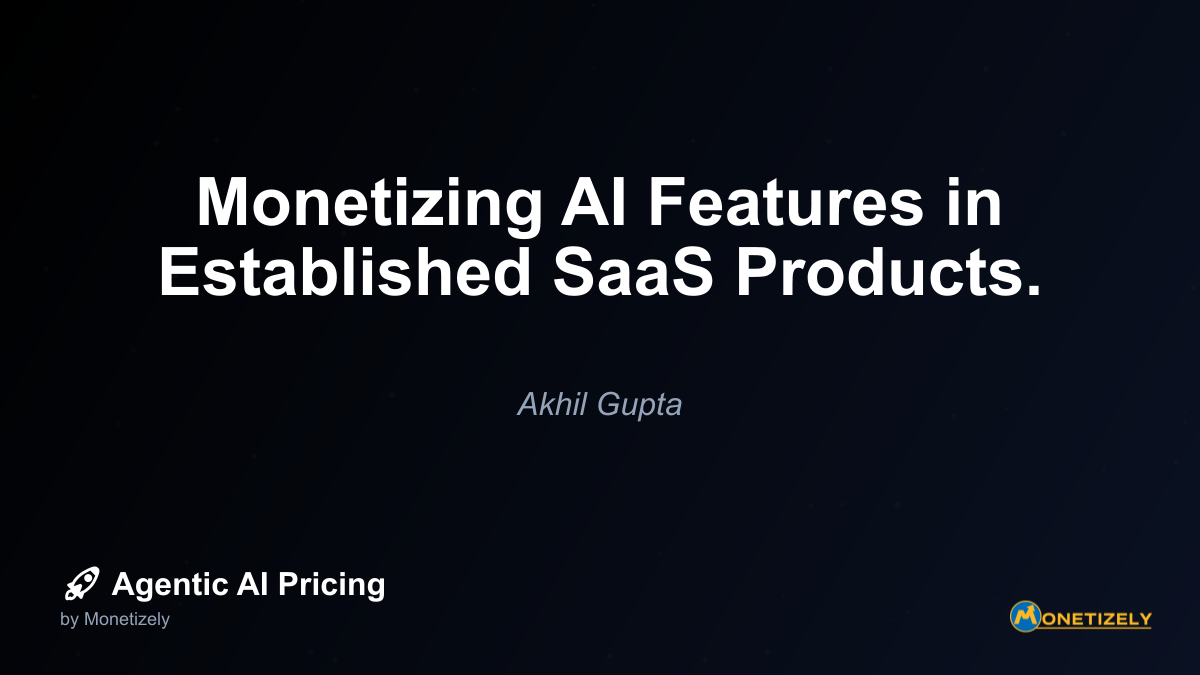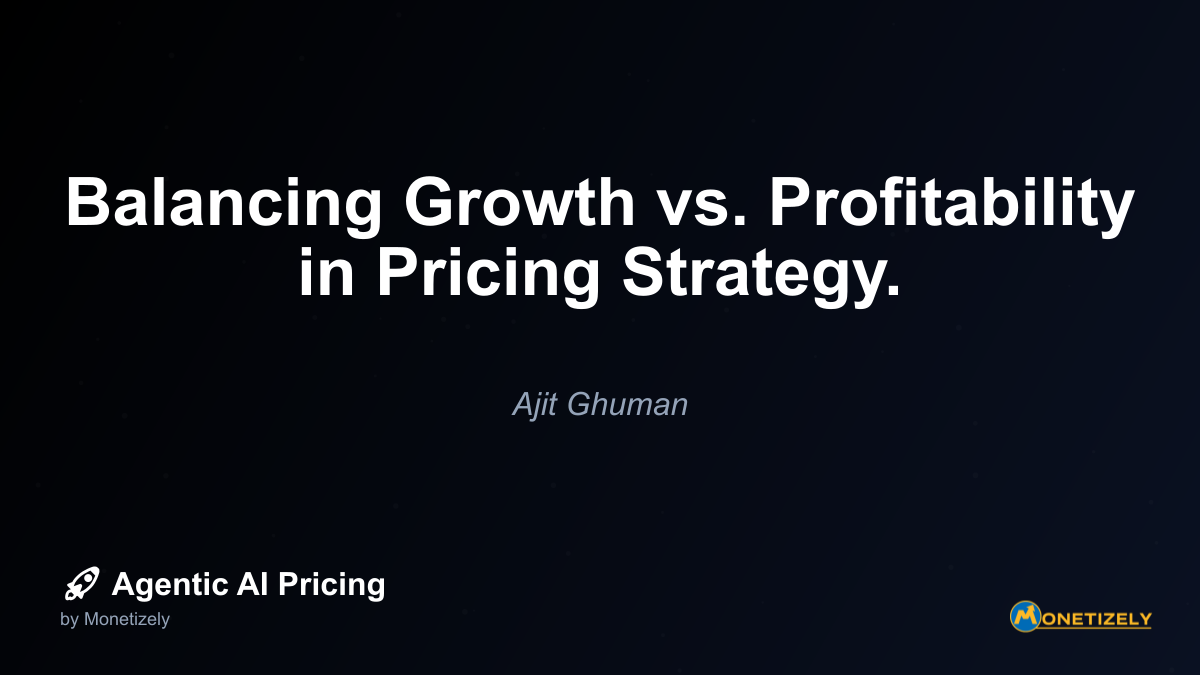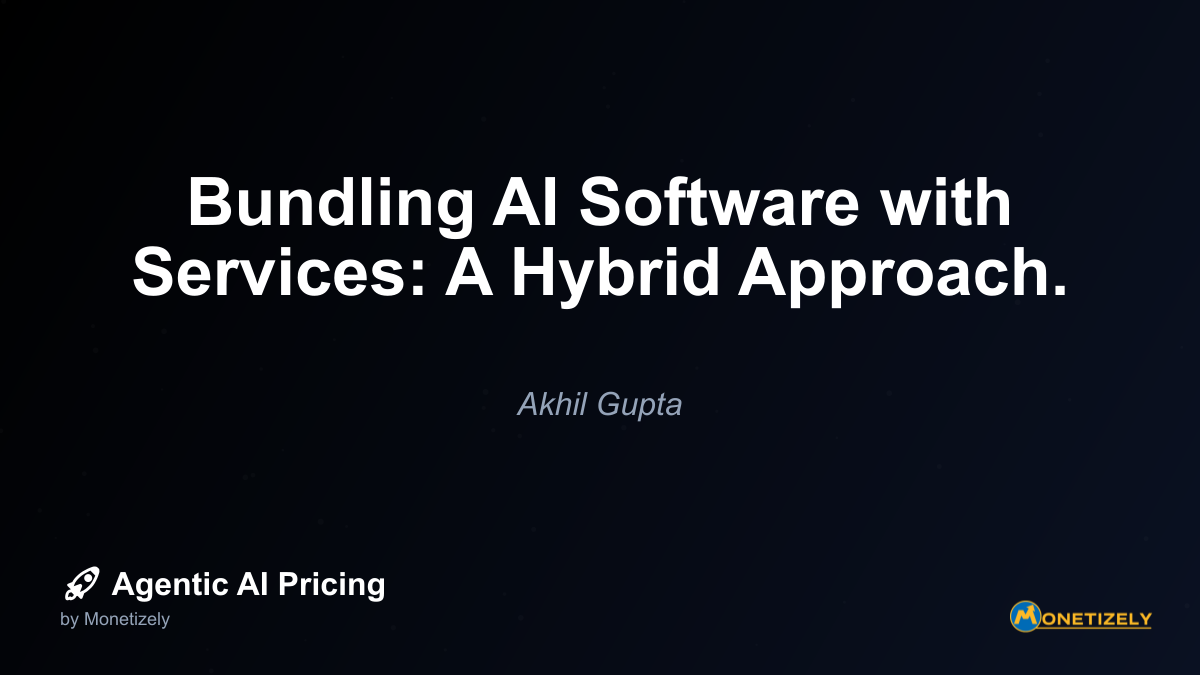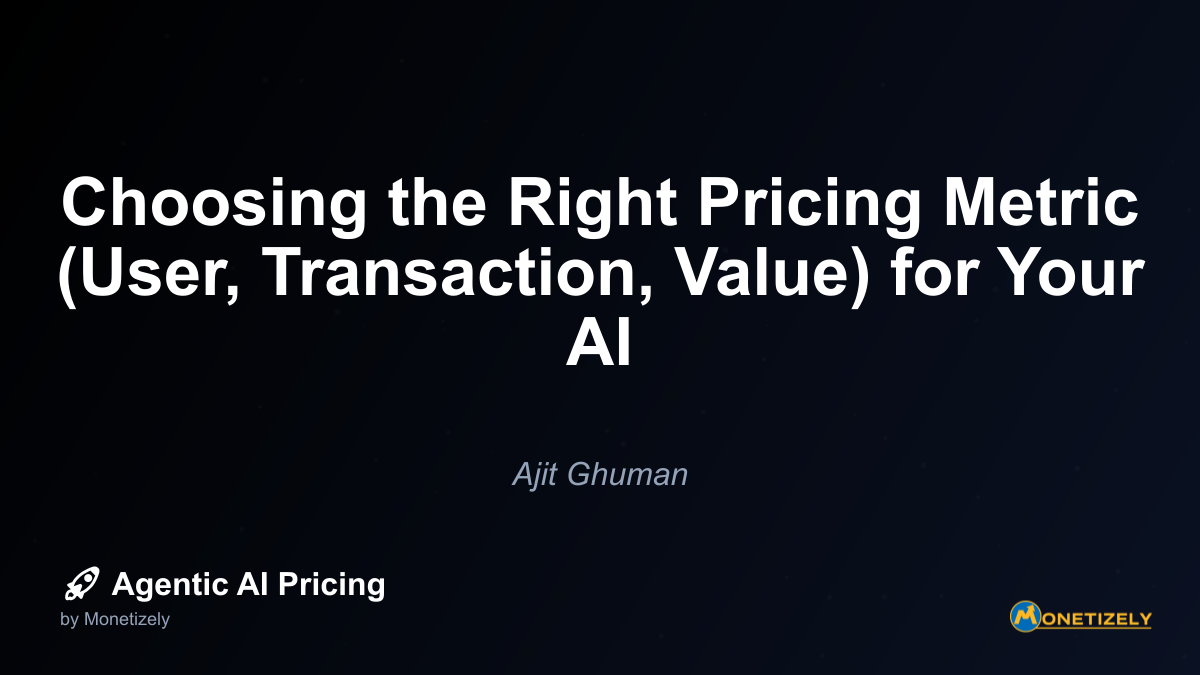· Akhil Gupta · Strategy & Planning · 12 min read
Monetizing AI Features in Established SaaS Products.
AI and SaaS Pricing Masterclass
Learn the art of strategic pricing directly from industry experts. Our comprehensive course provides frameworks and methodologies for optimizing your pricing strategy in the evolving AI landscape. Earn a professional certification that can be imported directly to your LinkedIn profile.

Three Strategic Approaches to AI Feature Monetization
When integrating AI capabilities into an established SaaS product, companies typically pursue one of three monetization strategies: bundling AI features into existing plans, offering AI as premium add-ons, or creating entirely new AI-powered tiers. Each approach carries distinct advantages and challenges that must be carefully weighed against the company’s market position, customer base characteristics, and long-term vision.
1. Bundling AI Features into Existing Plans
Bundling involves incorporating AI capabilities into existing subscription tiers, potentially with a modest price increase to reflect the enhanced value. This approach prioritizes customer retention and product evolution over immediate revenue maximization.
Advantages:
- Strengthens value proposition for existing customers
- Creates natural product evolution narrative
- Reduces friction in feature adoption
- Maintains simplicity in pricing structure
- Potentially increases retention rates
Challenges:
- May leave revenue on the table from customers willing to pay more
- Difficult to recoup significant AI development investments
- Can create feature bloat if not carefully implemented
- May undervalue truly transformative AI capabilities
Implementation Considerations:
- Assess whether AI features enhance core product functionality or represent entirely new capabilities
- Consider a modest price increase (5-15%) that reflects added value without triggering subscription cancellations
- Prioritize AI features that benefit the broadest customer segments
- Communicate the enhancement as product evolution rather than an optional extra
Real-World Example: Grammarly initially incorporated its AI writing suggestions into its core product, gradually enhancing the sophistication of its AI capabilities while maintaining its fundamental value proposition of improved writing. This approach allowed them to steadily increase prices over time while expanding their user base.
2. Offering AI as Premium Add-ons
The add-on approach involves keeping core plans intact while offering AI capabilities as optional purchases. This creates a supplementary revenue stream without disrupting the existing pricing structure.
Advantages:
- Preserves existing pricing structure for current customers
- Creates incremental revenue opportunities
- Allows for precise value-based pricing of specific AI capabilities
- Enables experimentation with different AI features and pricing points
- Provides clear ROI measurement for AI investments
Challenges:
- May create a fragmented user experience
- Requires additional sales and marketing efforts
- Can increase complexity in the buying decision
- Potential for customer confusion about which features require additional payment
Implementation Considerations:
- Package AI features that solve specific use cases rather than selling individual capabilities
- Price add-ons based on measurable customer value (time saved, improved outcomes)
- Consider consumption-based pricing for features with variable usage patterns
- Create seamless upgrade paths that minimize friction
- Develop clear messaging that differentiates core and premium capabilities
Real-World Example: HubSpot offers its AI content assistant as a separate add-on to its marketing platform. This approach allows customers to opt-in to AI capabilities based on their specific needs while maintaining the core value proposition of their marketing automation suite.
3. Creating New AI-Powered Tiers
This approach involves establishing entirely new subscription tiers centered around AI capabilities, often positioned as premium offerings above existing plans.
Advantages:
- Creates clear differentiation between standard and AI-enhanced offerings
- Enables significant price premiums for advanced capabilities
- Provides natural upsell path for customers seeking more value
- Establishes market positioning as an AI-forward solution
- Allows for targeting of different customer segments with appropriate features
Challenges:
- May create perception of a “two-class system” among customers
- Requires substantial product differentiation to justify tier separation
- Can complicate the sales process and lengthen decision cycles
- Risks cannibalizing existing tiers if value differential isn’t clear
Implementation Considerations:
- Ensure AI-powered tiers deliver substantial, measurable value beyond standard offerings
- Consider creating industry-specific or use-case specific AI tiers
- Develop clear migration paths for customers ready to upgrade
- Maintain some AI capabilities in standard tiers to prevent feature starvation
- Use tier naming and positioning to signal premium value (e.g., “Pro” vs. “AI Pro”)
Real-World Example: Salesforce introduced Einstein as a premium tier across its product suite, creating clear differentiation between standard CRM capabilities and AI-enhanced offerings. This tiered approach has allowed them to command significant price premiums while establishing market leadership in AI-powered business solutions.
Determining the Right Monetization Strategy for Your SaaS
The optimal approach for monetizing AI features depends on several critical factors unique to each SaaS business. Before implementing any pricing strategy, companies should conduct a thorough assessment of the following elements:
Customer Value Assessment
The foundation of any successful AI monetization strategy is a clear understanding of the value these features deliver to customers. This assessment should:
- Quantify time savings - Calculate how much time users save through AI automation (e.g., “Reduces report generation from 4 hours to 30 minutes”)
- Measure outcome improvements - Identify how AI enhances results (e.g., “Increases email response rates by 22%”)
- Evaluate competitive advantage - Determine how AI capabilities position users relative to their competitors
- Calculate financial impact - Translate AI benefits into monetary terms (cost savings, revenue generation)
The more precisely you can measure and articulate value, the more effectively you can price your AI capabilities. Features that deliver transformative value may warrant premium pricing, while those that offer incremental improvements might be better bundled into existing plans.
Cost Structure Analysis
AI features often introduce new and variable cost structures that traditional SaaS products don’t encounter:
- Computation costs - AI inference can incur significant and variable processing expenses
- Model licensing fees - Third-party AI models may require per-use payments
- Data storage requirements - AI training and personalization often demand increased storage
- Ongoing model improvement - AI requires continuous refinement and monitoring
Understanding these costs is essential for sustainable pricing. If a feature costs $0.02 per use to deliver, pricing it at $0.01 per use or bundling it into a fixed subscription could quickly become problematic at scale.
Competitive Landscape Evaluation
A thorough analysis of how competitors are monetizing similar AI capabilities provides crucial context:
- Feature comparison - Identify which AI capabilities competitors offer and how they’re packaged
- Pricing benchmarks - Determine market rates for comparable AI features
- Positioning strategies - Analyze how competitors frame the value of their AI offerings
- Customer reception - Gauge market response to competitors’ AI monetization approaches
This analysis helps prevent both underpricing (leaving money on the table) and overpricing (creating competitive disadvantages) your AI features.
Customer Segmentation Impact
Different customer segments often perceive AI value differently, which may influence your monetization approach:
- Enterprise vs. SMB needs - Larger organizations may value different AI capabilities than smaller ones
- Vertical-specific requirements - Industry-specific AI applications may warrant different pricing
- Technical sophistication - More technically advanced customers may value different AI features
- Usage patterns - High-volume users may respond differently to usage-based pricing than occasional users
For companies with diverse customer bases, a hybrid monetization approach may be optimal, with different strategies for different segments.
Implementing AI Monetization Without Alienating Customers
Perhaps the greatest challenge in monetizing AI features is doing so without disrupting existing customer relationships. The following strategies can help navigate this delicate transition:
Transparent Value Communication
Customers are more receptive to pricing changes when they clearly understand the value they’re receiving:
- Quantify benefits - Use specific metrics and case studies to illustrate AI advantages
- Provide ROI calculators - Help customers determine their personal value from AI features
- Offer comparison tools - Show side-by-side results with and without AI capabilities
- Create educational content - Develop resources that explain how AI improves outcomes
Rather than simply announcing new AI features and their cost, focus on communicating how these capabilities translate to tangible benefits worth the investment.
Grandfathering and Transition Strategies
Abrupt pricing changes can trigger customer backlash. Consider these approaches to ease transitions:
- Grandfathering existing customers - Maintain current pricing for existing users for a defined period
- Phased implementation - Gradually introduce AI features and associated costs
- Trial periods - Offer extended access to new AI capabilities before charging
- Loyalty discounts - Provide special pricing for long-term customers
- Usage allowances - Include a base level of AI usage before additional charges apply
Balancing bundled versus separate AI pricing requires thoughtful transition planning that respects existing customer relationships while moving toward sustainable monetization.
Tiered Access Models
Creating differentiated access levels can accommodate various customer needs and willingness to pay:
- Basic AI features - Include foundational AI capabilities in standard plans
- Advanced AI capabilities - Reserve more sophisticated features for premium tiers
- Usage thresholds - Set different usage limits for each pricing tier
- Customization levels - Offer increasing degrees of AI personalization at higher tiers
- Priority processing - Provide faster AI processing for premium customers
This approach allows customers to self-select the appropriate level of AI functionality based on their perceived value and budget constraints.
Feedback Loops and Adjustment Mechanisms
Monetizing AI features should be viewed as an iterative process rather than a one-time decision:
- Beta programs - Test pricing with select customer groups before full rollout
- Satisfaction monitoring - Track how pricing changes impact customer sentiment
- Usage analysis - Observe how pricing affects feature adoption and utilization
- Regular reassessment - Schedule periodic reviews of your AI monetization strategy
- Flexibility frameworks - Build mechanisms for adjusting pricing based on feedback
The most successful companies maintain open communication channels with customers and demonstrate willingness to evolve their approach based on market response.
Case Studies: Successful AI Monetization in Established SaaS
Examining how leading companies have successfully monetized AI features provides valuable insights for developing your own strategy:
Zendesk: The Tiered AI Approach
Strategy: Zendesk implemented a tiered approach to AI monetization by creating a dedicated “AI Suite” while also incorporating basic AI capabilities into standard plans.
Implementation:
- Included fundamental AI-powered answer suggestions in all plans
- Created premium AI Suite with advanced capabilities (sentiment analysis, intent recognition)
- Priced the AI Suite as a percentage of base subscription (approximately 25% premium)
- Developed clear ROI messaging focused on agent efficiency and customer satisfaction
Results:
- Achieved 40% adoption of AI Suite among enterprise customers
- Maintained customer satisfaction through transparent value communication
- Successfully positioned AI capabilities as enhancing rather than replacing human agents
- Established market differentiation as an AI-forward customer service platform
Key Lesson: Providing basic AI functionality in standard plans while reserving advanced capabilities for premium offerings can create a natural upgrade path that customers understand and value.
Adobe: The Feature-Based Add-On Strategy
Strategy: Adobe adopted an add-on approach for its Sensei AI capabilities across its Creative Cloud suite, allowing customers to select specific AI features relevant to their workflow.
Implementation:
- Maintained core Creative Cloud pricing structure
- Offered AI capabilities as feature-specific add-ons (e.g., Content-Aware Fill, Auto Reframe)
- Priced add-ons based on professional time saved and outcome improvement
- Created bundle options for customers needing multiple AI capabilities
Results:
- Generated incremental revenue without disrupting core subscription model
- Achieved high adoption rates among professional users
- Maintained pricing flexibility across diverse customer segments
- Established clear value connection between AI capabilities and professional outcomes
Key Lesson: Packaging AI as discrete, value-based add-ons can allow customers to invest specifically in capabilities that enhance their particular workflows, increasing perceived value and willingness to pay.
HubSpot: The Evolutionary Bundling Approach
Strategy: HubSpot gradually incorporated AI capabilities into its core platform while introducing more advanced AI features as premium offerings.
Implementation:
- Included basic AI functionality (predictive lead scoring, content suggestions) in standard plans
- Introduced more sophisticated AI tools (content generation, optimization) as add-ons
- Communicated enhancements as natural product evolution rather than upsells
- Used freemium access to introduce AI capabilities before monetization
Results:
- Maintained high customer satisfaction through gradual enhancement approach
- Successfully upsold 30% of enterprise customers to advanced AI features
- Established perception as an innovative, customer-centric platform
- Created sustainable revenue growth without significant customer churn
Key Lesson: An evolutionary approach that gradually introduces and then monetizes AI capabilities can maintain customer satisfaction while still capturing the value of AI investments.
Measuring Success: KPIs for AI Monetization
Implementing the right metrics to evaluate your AI monetization strategy is essential for ongoing optimization. Consider tracking these key performance indicators:
Financial Metrics
- AI Revenue Contribution - Percentage of total revenue derived from AI features
- Customer Lifetime Value (CLV) Impact - How AI features affect overall customer value
- Average Revenue Per User (ARPU) Change - Increase in ARPU after AI implementation
- Cost-to-Serve Ratio - How AI delivery costs compare to revenue generated
- Payback Period - Time required to recoup AI development investments
Adoption Metrics
- Feature Utilization Rate - Percentage of eligible customers using AI capabilities
- Engagement Depth - How extensively customers use available AI features
- Adoption Velocity - Speed at which customers implement AI capabilities
- Cross-Feature Adoption - Whether AI users adopt other premium features
- User Segment Adoption - How adoption varies across customer segments
Customer Impact Metrics
- Net Promoter Score (NPS) Differential - How AI features affect customer satisfaction
- Churn Rate Impact - Effect of AI features on customer retention
- Expansion Revenue - Additional spending from customers using AI features
- Feature Satisfaction - Specific feedback on AI capability performance
- Support Ticket Volume - How AI features affect customer support requirements
Competitive Position Metrics
- Win Rate Changes - Impact of AI capabilities on competitive wins
- Price Premium Sustainability - Ability to maintain higher pricing versus competitors
- Market Perception - Analyst and industry recognition of AI capabilities
- Feature Parity Gap - How your AI offerings compare to competitive alternatives
- Innovation Perception - Customer perception of your company as an AI leader
Future-Proofing Your AI Monetization Strategy
The AI landscape is evolving rapidly, requiring monetization strategies that can adapt to changing technologies, customer expectations, and competitive pressures. Consider these approaches to build flexibility into your AI pricing:
Modular Pricing Architecture
Develop a pricing framework that allows components to be adjusted independently:
- Decoupled feature pricing - Separate pricing for different AI capabilities
- Flexible consumption models - Ability to shift between subscription and usage-based approaches
- Tiering flexibility - Framework for adding or adjusting pricing tiers
- Discount management - Systematic approach to promotional pricing and discounts
- Value-metric evolution - Ability to change how you measure and price AI value
Continuous Value Reassessment
Implement processes for regularly reevaluating the value delivered by AI features:
- Value tracking - Ongoing measurement of customer outcomes and benefits
- Competitive benchmarking - Regular assessment of market pricing for similar capabilities
- Cost monitoring - Tracking of changes in AI delivery costs
- Customer value surveys - Periodic research on perceived value and willingness to pay
- Usage pattern analysis - Identification of how value realization changes over time
Contractual Flexibility
Structure customer agreements to accommodate evolution in AI capabilities and pricing:
- Term optimization - Balance between contract length and pricing flexibility
- Change provisions - Clear language regarding feature and pricing adjustments
- Grandfathering clauses - Defined periods for maintaining legacy pricing
- Usage growth accommodation - Mechanisms for handling increased AI utilization
- Technology evolution clauses - Provisions for introducing new AI capabilities
Customer Communication Planning
Develop a strategic approach to managing customer expectations around AI pricing:
- Value narrative - Consistent messaging about AI value and investment requirements
- Roadmap transparency - Appropriate sharing of future AI capability plans
- Pricing philosophy - Clear articulation of how you approach AI monetization
- Change management protocols - Structured process for communicating pricing adjustments
- Feedback mechanisms - Channels for customers to share pricing concerns and suggestions
Conclusion: Balancing Innovation and Customer Relationships
Successfully monetizing AI features in established SaaS products requires careful balance between capturing fair value for innovation and maintaining strong customer relationships. The companies that excel in this transition typically share several characteristics:
They prioritize value demonstration over feature announcements, helping customers understand exactly how AI capabilities improve their outcomes.
They implement graduated approaches rather than abrupt changes, allowing customers time to adjust to new capabilities and pricing structures.
They maintain pricing flexibility across different customer segments, recognizing that AI value varies significantly by use case and organization type.
They invest in transparent communication, clearly explaining the investments required to deliver AI capabilities and the value
Co-Founder & COO
Akhil is an Engineering leader with over 16+ years of experience in building, managing and scaling web-scale, high throughput enterprise applications and teams. He has worked with and led technology teams at FabAlley, BuildSupply and Healthians. He is a graduate from Delhi College of Engineering and UC Berkeley certified CTO.
Pricing Strategy Audit
Let our experts analyze your current pricing strategy and identify opportunities for improvement. Our data-driven assessment will help you unlock untapped revenue potential and optimize your AI pricing approach.




